
|   |

|   |
 e-mail: leelakaverivenkat@gmail.com Moving requiem to Kapila Vatsyayan - the only guru of her kind October 5, 2021 Sponsored and premiered by the Sangeet Natak Akademi as homage, on the death anniversary of the inimitable scholar late Dr. Kapila Vatsyayan, was a virtual presentation, curated and presented by one who remained her lifelong student - namely Navina Jafa. A uniquely simple assembling of researched information, followed by an imaginatively designed collective tribute with scholars and artistes from different areas participating, Kathak Dance - New Perspectives of History Supervision and Hindol Darshan, were both reworked virtual packages of Navina's earlier live lec/dem presentations. Arguably the most persistent among myriads of aspirants functioning under Kapilaji's baton, Navina Jafa is perhaps the only one to have earned her doctorate, guided by one she refers to, as "India's first woman rishi" - widely acknowledged as an exacting and daunting teacher (though she herself refused to acknowledge that she was a guru with shishyas.). 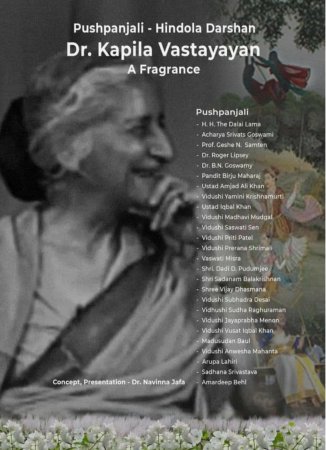 Poster designed by Amardeep Behl The first very concise programme "Kathak Dance- New Perspectives of History" underlined how Kathak practiced in the entire region of North India and parts of the South (in ten and more politically linguistic states), and in foreign countries like Pakistan, Bangladesh, Nepal ,including places in Central Asia and West Asia, is a prolific dance form. With myriad practitioners not barred by class, community, occupation or gender, Kathak in its flow through history, has a DNAcomprising influences from many sources within and outside India. Within India, what finally emerged as the dance form was influenced by the temple, the Court and all other performance spaces where there was music and dance. Dance is a process not fashioned by a linear history. In what has predominantly been an oral tradition, the Katha Vachaks and professional story tellers, including narrators from the Hindu Shaivite and Vaishnavite traditions, the Natwaris with their 'bols', the Mughals as art patrons and sometimes even performers, written works like Nartan Nirnaya, etc - have all contributed to this flow of a cultural tradition with the Naach, the Nartan, the Raks (in Arabic language) etc. The palm leaf manuscripts, records left behind by pilgrims, details of court life, sculpture, miniature paintings are all rich sources of historical proof - in what is in reality a 'manthan' (churn of myriad influences). Thus, one will find that the dance as known today, has evolved from features resulting from cultural exchanges through trade, migrations, invasions and other historical processes down the years. 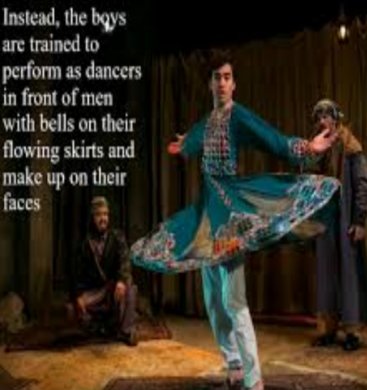 A Baccha dancer from Afghanistan Navina pointed out certain misconceptions and generalisations about Kathak, not fully supported by research into history. Listing neatly the salient aspects adding up to the Kathak identity, Navina referred to its central stylistic feature of erect body with straight stance, which is totally unlike all other Indian forms which have the knee bend with the plie as the central stylistic concern.The flowing nature of movements with the delicate wrist, torso, neck etc kasakmasak are also special to Kathak. The most defining Kathak feature, namely the manner in which ghungroos (ankle bells) are used to create very articulated aural patterns with footwork, is also a feature which was not special to India. Navina mentioned the Ethiopian tribes who wore bells high up on the knees and danced, and so did the Greek Yavanas during the time of Alexander who invaded India and fought Porus, as early as in 320 B.C. There was sexual exploitation of young boys made to dance with ankle bells, and one knows of the Bachhabazi, another abusive form using ghungroo wearing young boys in dance in Afghanistan and parts of Asia Minor. Cross country interactions through migrations of Gypsologists or Romanis, gypsy Jats of North India who migrated to Europe and who performed with ankle bells doing fast footwork, provide instances of how aspects seen in Kathak as recognised today, have been influenced by and in turn influenced dances in Europe (like the Flamenco dance) and other places. Parhant reciting aloud the rhythmic syllables of a nritta composition and Hindustani music, are also important features of Kathak and Hindustani music certainly is a blend of aspects indigenous to India, and what came from outside. And unlike other dance forms where the performer dances to a tala (metrical beat), the Kathak dancer performs the tala per se. The dupatta used by both male and female performer adds a third dimension to movements, particularly as the dancer swirls. 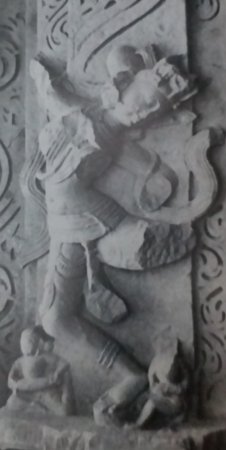 10th c sculpture Khajuraho evidence of Dupatta Navina also broke the myth of the chakkar being spoken of as Sufi influence. Sufi Kathak as it is called today has no historical evidence to back it. The Turks and Sufis, when intoxicated while meditating on Allah, slowly circle - the body becoming a rosary during the mantra Jap, as Navina put it. This movement has no formal classical prescription behind it. In Sufi philosophy, dance is not accepted and it is wrong to attribute the chakkar in Kathak to the Sufis. While delving into history of a dance, one needs to decode myths, taking into consideration both Prayog and Sastra. And one needs to understand that the word 'kathak' even as late as the beginning of the 20th century, referred to a community of people - and not to story tellers (common to all traditions). 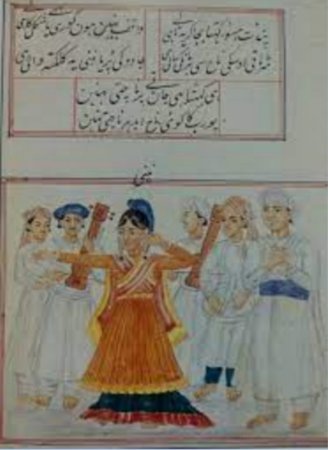 19th c Rampur Court Album of a performance with nuances evident in Kathak Just as dwandh or opposites contradict and complement each other through contrasts, so is the up and down movement of the swing (Jhoola) - a metaphor for life with its constant highs and lows. Just as the motion of the swing finds an equilibrium amidst its peaks and abysses, life with its unpredictability still has to find a balance and it is this equilibrium as a state-of-being that art and religious philosophies in India stress. Herein lies the symbolism behind the Jhoola. Hindol represents this wondrous journey (adbhut Jhoola) for between Gyan and Agyan, it is sat, chit, anand that all humans try to attain. The arts in India constitute the greatest metaphor, trying to attain a state of that bliss of complete detachment and selflessness. Not surprising that the old homes and gardens were never complete without the swing and Jhoolan Jatras and festivals throughout the country, celebrate deities in temples taken in procession, partaking in this metaphorical swing of life. The garlanded bride and groom seated on the oonjal in a south Indian wedding with sumangalis singing songs meant for the occasion (rendered by Sudha Raghuraman in the programme) again symbolises the prayer and good wishes to the couple to find harmony amidst the unexpected hopes and disappointments of life. Madhavi Mudgal talked about the swing-like contrasts in the fast and slow Odissi movements and lilt and gait of the torso movements in Odissi, not to speak of the undulating music of the recited 'ukkutas'- the rhythmic syllables in a nritta sequence, and the gamakas in the music rendition. No wonder that the great scholar Dr.Saxena in his inimitable books on Kathak refers to the language of mnemonic syllables as "swinging syllables". Even nature in Odisha highlights these contrasts in the swings of weather - the dry spell of Summer followed by the celebratory spirit of Raja Mahotsav with the onset of Spring. Ustad Iqbal Khan sings the traditional Jhoola composition based on Hazrat Khusru's poetry "Jhulakinne dalo re Amraiya". Nature is full of these contrasts of high and low and after all culture as Kapilaji put it, is a human response to geography. Prerana Shrimali spoke of how different aspects of a personality can be compared to the five elements of nature - each with a singularly different identity. All of nature in the high energy and low energy moods of its seasons emulates the up and down movements of the swing. Whether it is the mysticism of Baul singing with the dubki by Madhusoodan Baul, a song of Ghoraknath or of Adi Shankara's Bhaja Govindam, the philosophy behind is to retain one's balance in life, accepting the high and low points. Navina Jafa's skilful and poetically imaginative way of weaving this metaphor round the personality of late Kapila Vatsyayan made for a memorable homage. Reputed art critics like Sardar Ali Jafri and B.N. Goswami expressed their homage to one who had contributed so extensively to Indian artistic thought. Navina showed that if Achhan Maharaj taught young Kapila the mathematics of finding equilibrium through the measurement of time through Kathak bols, Guru Amubi Singh taught her the depths of inner concentration one can invoke through the Manipuri movement swing. If Pandit Birju Maharaj could lose himself in the ecstasy of the Gopi in a jhoola song "Logova jhulna jhulave Yashomati warijaye..." or Bharatanatyam dancer Arupa Lahiri in the interpretation of a Kabir doha (made famous by singer Vidya Rao) "Koi prem ke penge jhulade", Sadanam Balakrishnan experienced this balance in his Kathakali. Ustad Amjad Ali Khan experienced this state of utter bliss with the high and low notes of the sur on the Sarod and Dadi Padamji found his high points and contentment in the fashioning of and guiding the play of his Nori puppets. For Dr. Kapila Vatsyayan, it was this cosmic rhythm of Shiva dancing in glory, that the great Yamini Krishnamurty seemed to touch in her dance in Chidambaram in front of the idol of Nataraja - the God of Dance. It revoked old memories when Anwesa Mahanta, the Sattriya dancer and scholar, performed to a prayer taken from Madhavadeva's work, something that had deeply moved Kapilaji, when the dancer had rendered it before her. Swimming in the river of knowledge, a confused Manipuri dancer Priti Patel or Manipuri singer Potsangbam Sanahanbi Devi, discovered through Manipuri and its music, the Yantra and kaal chakra mandala. Nobody understood the profundity of this circle of the mandala chakra nor explained it more lucidly through lectures and writings, like Kapilaji did. In a well lived life filled with the intriguing cadence of the swing with its coiled ropes of Satva, Rajas and Tamas, amidst life's inspiration and expiration, her search never stopped. For Kapilaji with all her learning and constant exploring, the best method of finding equilibrium and ways to resolve the conflicts of life, for the world, was through cultural and artistic exchanges - enabling one to understand the other. And it was this larger application of art and culture in the understanding of mankind that she sought. 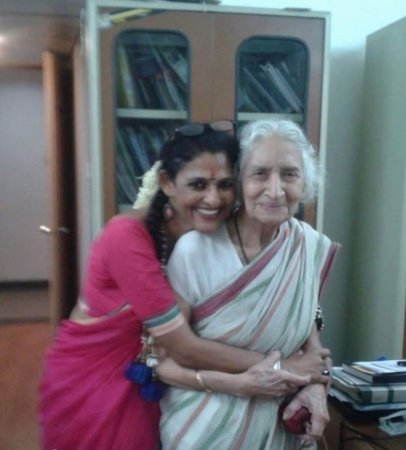 Navina Jafa and Kapilaji on Gurupurnima 2017 While those who watched the programmes responded in individual ways, in a painstakingly compiled work, there were two aspects, which intrigued this critic. For people who had watched the daunting courage and stoicism with which Kapilaji faced her fast failing sight,the starting scene of the Kathak Research programme was neither here nor there - with what was described as an agitated Kapilaji asking to be rushed to the hospital (and after being admitted by Navina) and learning that her eyes were at fault. She then began to educate the doctors about the eye - quoting from Yoga Sutra, Mahabharata, Ramayana, Physics, Chemistry, Architecture etc. The whole scene stuck out like a sore thumb, not fitting in with the rest. Hindol, very thoughtfully curated, with Navina's introductory passages followed by moving excerpts by participating artists and scholars, did make for poetic moments. That being so, for this critic the hyped delivery in the introductions, bordering on theatre, should perhaps have been toned down.  Writing on the dance scene for the last forty years, Leela Venkataraman's incisive comments on performances of all dance forms, participation in dance discussions both in India and abroad, and as a regular contributor to Hindu Friday Review, journals like Sruti and Nartanam, makes her voice respected for its balanced critiquing. She is the author of several books like Indian Classical dance: Tradition in Transition, Classical Dance in India and Indian Classical dance: The Renaissance and Beyond. Response * Just found this fine tribute today. Thanks to all who made the virtual presentation to honor iconic Dr Kapila Vatsyayan. I'll try to locate a copy ... Was blessed to know (and be blessed by) Kapila-ji : first introduced 25 yrs ago by H E Ambassador Aftab Seth in Tokyo @ Int'l House of Japan (where I had earlier performed); later with conversations in Delhi; and her kind (active!) participation in my 2013 lecture-concert "Aural Crossroads in the Asian Century - Traditional Japanese instruments in lndian classical music" (5th event there since 1992). Though a performing musician & musico-linguistic scholar, I am privileged to know & work somewhat with exalted dance artists in both N & S India. Dr Leela Samson had hosted my lec-dem in Kalakshetra (and later kindly hosted our troupe of 4 from Japan), Vasundhara Doraswamy also collaborated w/us some 30 yrs ago; Gyanendra Bajpai in Lucknow & Japan; Birju Maharaj was close relative of my Hindustani classical vocal Guruji late Pdt Ganesh Prasad Mishra ... etc. Jai Naad & Nataraj. - T M Hoffman @ Indo-Japanese Music Exchange Assn (Nov 30, 2025) Post your comments Pl provide your name and email id along with your comment. All appropriate comments posted with name and email id in the blog will also be featured in the site. |